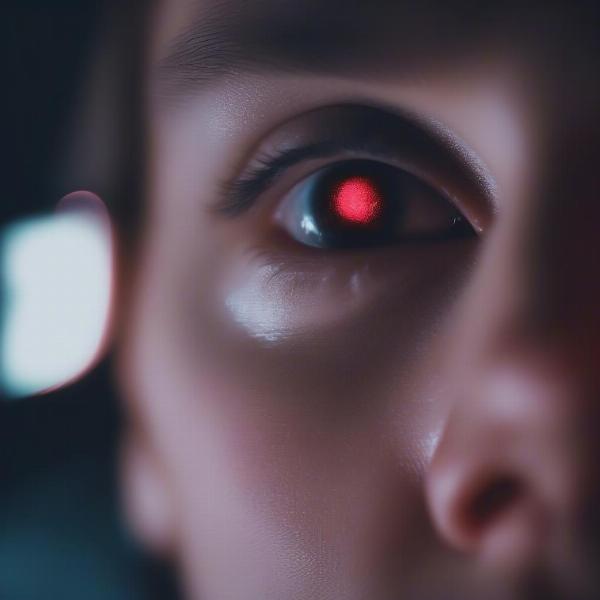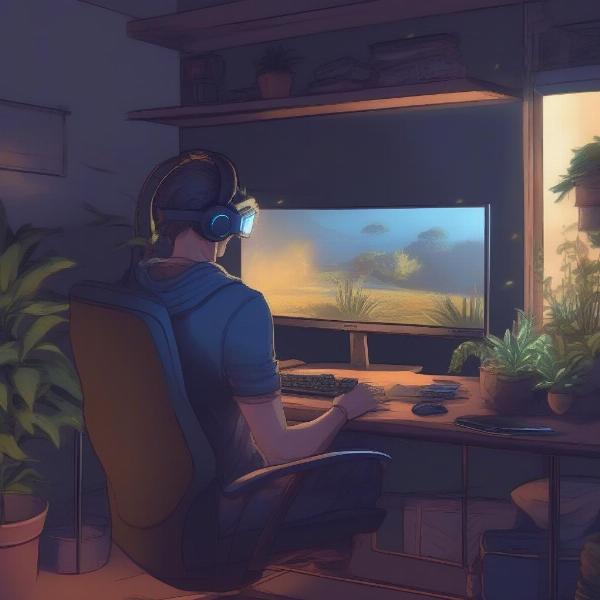Is It Bad To Play Video Games In The Dark? It’s a question many gamers ponder, especially after a marathon session leaves their eyes feeling strained. While the appeal of immersive darkness is undeniable, there are potential downsides to consider. This article delves into the effects of playing video games in the dark, exploring both the benefits and drawbacks for your eyes, sleep, and overall well-being.
The Allure of Darkness in Gaming
Many gamers find playing in the dark enhances the gaming experience. The reduced ambient light can create a more immersive atmosphere, drawing players deeper into the virtual world. The heightened contrast between the screen and the surrounding darkness can make colors appear more vibrant and details sharper, particularly in dimly lit game environments. This can be especially appealing in horror games or those with dramatic lighting effects. However, this perceived visual improvement comes at a potential cost.
Eye Strain and Playing Video Games in the Dark
Playing video games in the dark can contribute to eye strain. The stark contrast between a bright screen and a dark room forces your eyes to work harder to adjust, leading to fatigue. Symptoms of eye strain can include dry eyes, blurry vision, headaches, and even neck and shoulder pain. Prolonged exposure to this high contrast can potentially exacerbate existing eye conditions.
 Eye Strain from Playing Video Games in the Dark
Eye Strain from Playing Video Games in the Dark
The Impact on Sleep: Is Gaming in the Dark Affecting Your Zzz’s?
Playing video games in the dark, especially close to bedtime, can disrupt your sleep cycle. The blue light emitted from screens suppresses melatonin production, a hormone that regulates sleep. This can make it harder to fall asleep and lead to poorer sleep quality. A well-regulated sleep cycle is crucial for overall health and cognitive function, so prioritizing healthy sleep habits is essential for gamers.
Tips for Minimizing the Negative Effects
While playing in complete darkness might be tempting, there are ways to mitigate the potential negative effects. Adjusting the screen brightness and contrast to a more comfortable level can significantly reduce eye strain. Using a bias light, a soft light placed behind the monitor, can also help reduce eye fatigue by minimizing the contrast between the screen and the surrounding environment.
 Tips for Reducing Eye Strain While Gaming
Tips for Reducing Eye Strain While Gaming
Creating a Healthy Gaming Environment
A healthy gaming environment involves more than just lighting. Taking regular breaks, following the 20-20-20 rule (looking at something 20 feet away for 20 seconds every 20 minutes), and ensuring proper room lighting are vital for eye health. Maintaining a comfortable viewing distance and using an ergonomic setup can further minimize strain and promote overall well-being. Remember, prioritizing your health ensures you can enjoy gaming for years to come.
Long-Term Considerations: Protecting Your Eyesight
The long-term effects of playing video games in the dark are still being studied. However, consistent eye strain can contribute to the development of various eye conditions. Protecting your eyesight should be a priority, and incorporating healthy gaming habits can make a significant difference. Regular eye check-ups are crucial for detecting and addressing any potential issues early on.
Dr. Anya Sharma, a leading ophthalmologist, advises, “While the immediate effects of gaming in the dark might seem minor, the cumulative impact over time can be significant. Prioritizing eye health by adopting healthy gaming habits is essential for preserving your vision.”
Finding the Right Balance: Enjoying Games Without Compromising Health
Ultimately, the key is finding the right balance. Gaming in the dark can enhance immersion, but it’s crucial to be mindful of the potential drawbacks. By implementing the tips discussed and prioritizing eye health, you can continue to enjoy your favorite games without compromising your well-being.
 A Balanced Gaming Setup for Optimal Health
A Balanced Gaming Setup for Optimal Health
Other Factors to Consider for Optimal Gaming Health
Beyond lighting, other factors can affect your health while gaming. Maintaining proper posture, taking regular breaks for physical activity, and staying hydrated are crucial for overall well-being. Remember, a healthy lifestyle complements a healthy gaming experience.
Michael “GamerDoc” Davies, a physical therapist specializing in gaming ergonomics, suggests, “Gamers often focus solely on their in-game performance, neglecting their physical well-being. Incorporating ergonomic principles and regular physical activity can significantly enhance both your gaming experience and overall health.”
Conclusion: Play Smart, Play Safe
So, is it bad to play video games in the dark? Not necessarily, but it’s essential to be aware of the potential risks and take steps to mitigate them. By adjusting your environment, prioritizing healthy habits, and listening to your body, you can enjoy countless hours of gaming without compromising your health. Remember, playing smart and safe ensures you can continue exploring virtual worlds for years to come.
FAQ
- What is the 20-20-20 rule for eye health? Every 20 minutes, look at something 20 feet away for 20 seconds.
- What are the symptoms of eye strain? Dry eyes, blurry vision, headaches, and neck/shoulder pain.
- How can I reduce eye strain while gaming? Adjust screen brightness, use a bias light, and take regular breaks.
- Does blue light affect sleep? Yes, blue light suppresses melatonin production, making it harder to fall asleep.
- What is a bias light? A soft light placed behind a monitor to reduce eye strain.
- How can I create a healthy gaming environment? Proper lighting, ergonomics, and regular breaks.
- What are the long-term effects of playing video games in the dark? Potentially increased risk of eye conditions due to consistent eye strain.

